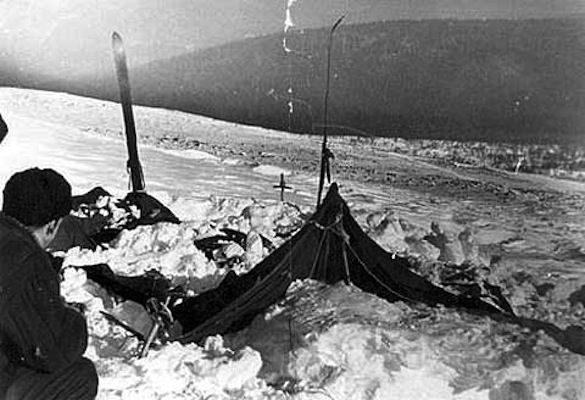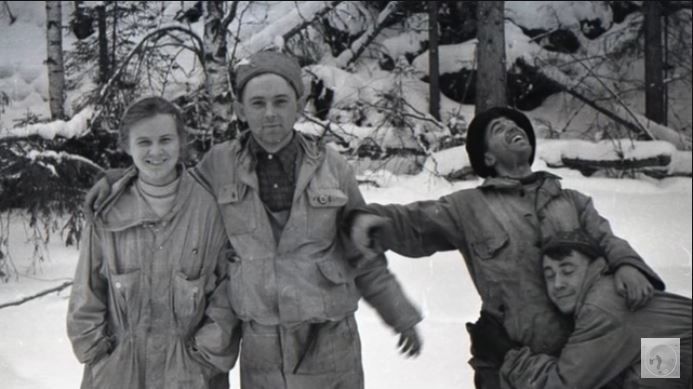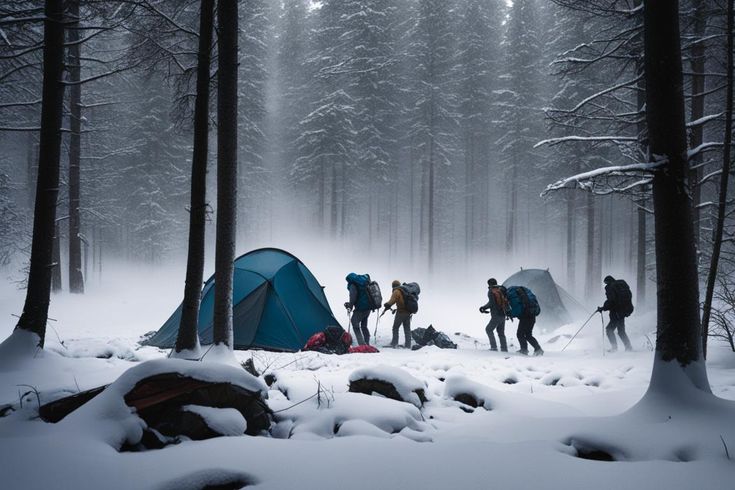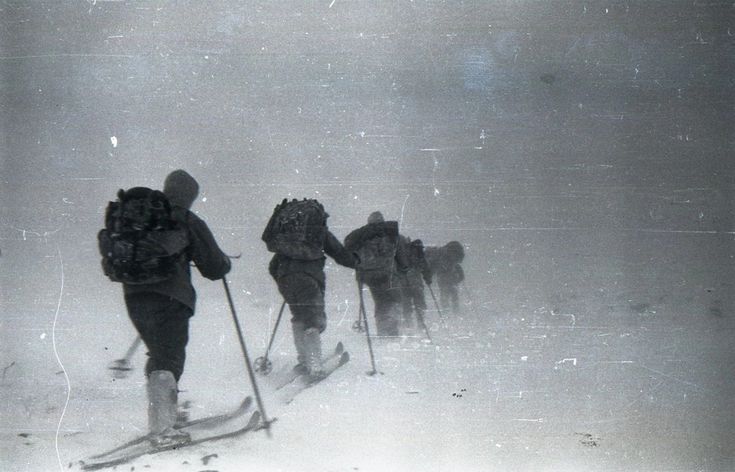The snow is silent, but not still.
It swirls slowly over a lonely mountain slope in the Ural Mountains, hiding something no one was ever supposed to find. Beneath that snow lies a tent that has been ripped open from the inside, as if the people inside were desperately trying to get out. A short distance away from the tent, barefoot footprints lead straight into the dark forest, like the people were running away from something no one could see.
This is the picture of what happened in February 1959.
Nine young hikers disappeared in freezing conditions that could kill anyone within minutes. When they were found days later, their bodies were scattered, buried in snow, some half-dressed, and some with injuries that made no sense. One of them had crushed bones with no bruises, another person had missing eyes, and a woman was missing her tongue.
To this day, no one, not Soviet investigators at the time, not modern scientists, not even decades of curious researchers, can say for certain what made the hikers leave their tent that night and flee into the freezing night without coats or shoes.
This case is not just a mystery. It is like a murder locked in the middle of a mountain range. A place where the only witness is nature itself…. And nature is keeping her mouth shut.
This is the story of the Dyatlov Pass mystery. It is one of the most confusing and haunting cases in the history of unexplained deaths in Russia. For more than six decades, people have argued over what happened that night. Was it an avalanche? Was it military experiments? Aliens? Or something far stranger?
Let’s go back in time and find out… if we can.
Where the Journey Starts
A 23-year-old engineering student from the Ural Polytechnic Institute, Igor Dyatlov, led the hikers. He was known for being calm under pressure and very resourceful, the kind of leader you would want if you were facing snowstorms in the middle of nowhere.

Apart from Igor Dyatlov, there were eight other hikers. All of them were young, adventurous, and experienced hikers. They include Zinaida Kolmogorova, Yuri Doroshenko, Lyudmila Dubinina, Rustem Slobodin, Alexander Kolevatov, Yuri Krivonischenko, Nikolai Thibeaux-Brignolles, and Semyon Zolotaryov.
They wanted to reach Otorten Mountain, a remote peak whose name in the local Mansi language means “Don’t Go There.“
Although there was a tenth member, Yuri Yudin, he turned back early due to a sudden illness. This twist of fate saved his life.
All nine hikers shared a common goal: they wanted to reach Otorten Mountain, a remote peak whose name in the local Mansi language translates to “Don’t Go There.” Whether that name was just a coincidence or a warning sign will forever be part of the mystery.
A Final Photo, a Final Camp
The group’s early days in the snowy mountains went smoothly. They skied through the forest, laughing, singing, and taking many photos. The pictures they took, which were later recovered from the cameras, showed them smiling, unaware of the tragedy ahead.
A wind-swept slope on Kholat Syakhl; another Mansi name that means “Mountain of the Dead.“
On February 1, 1959, the group reached a part of the mountain without trees. It was a wind-swept slope on Kholat Syakhl, another Mansi name meaning “Mountain of the Dead.” For reasons no one fully understands, they decided to camp right there on the slope instead of moving to the forest, a mile away, which would have given them more shelter from the wind.
There were speculations, such as, “Maybe they did not want to lose the altitude they had worked hard to gain.” “Maybe they were testing their skills in harsher conditions.”
Whatever their reasons were, we would never know. One thing we are sure of is that night would be their last.
The Search and the Shock
When the hikers failed to return on schedule, rescue teams were sent out. What they found over the next few weeks would become one of the most famous unsolved cases in the Soviet Union.

The first thing the searchers spotted was the tent. It was partially buried in the snow, but it was still standing. The fabric was slashed from the inside, as if the hikers had cut their way out in a hurry. Inside the tent, there were still boots, coats, and supplies. Whatever had driven them out was so frightening that they didn’t take the time to get dressed for the -30°C/-22°F temperatures.
They were dressed in only their underwear, and their hands were badly burned, as if they had tried to keep the fire from getting too close.
Outside the tent, footprints led toward a forest. At first, two bodies were found. Doroshenko and Krivonischenko’s bodies were lying by a small fire under a cedar tree. They were dressed in only their underwear, and their hands were badly burned, as if they had tried to keep the fire from getting too close.
As they continued searching, they found three more bodies. Dyatlov, Kolmogorova, and Slobodin were found between the tree and the tent; it looked like they had tried to return.
The remaining four hikers were not found until the snow melted months later. They were buried in a ravine, wearing bits of clothing like the others. This suggests that the survivors had tried to share garments after some had died.
However, their injuries were very shocking. Thibeaux-Brignolles had a crushed skull, Dubinina had broken ribs, no tongue, and missing eyes; Zolotaryov’s ribs were also shattered.
Yet strangely enough, their bodies had no external wounds. It was as if the force had been applied from within, as if they were involved in a car crash.
The Official Soviet Investigation
The Soviet investigation was short and vague. The final statement they gave was that the hikers had died due to a “compelling natural force.” No further explanation was given, files were quietly archived, and people were discouraged from asking questions.

However, the details leaked and rumors spread. Some people reported seeing glowing orange lights in the sky and strange radiation on certain clothes. The fact that the military restricted access to this area for years afterwards also fueled decades of speculation.
Theories That Refuse to Die
Over the years, various explanations have been proposed. Let’s look at the most famous Dyatlov Pass theories and see how they hold up.
1. Avalanche
The simplest theory is that a small avalanche occurred, hitting their tent and forcing them to flee into the night. This could explain why they desperately cut their way out of the tent and why they ran without gear. It might also explain the internal injuries, which could have been caused by pressure from the snow, and the snow covering the later bodies.
However, there are problems:
- The slope was not steep enough for a typical avalanche.
- There was no clear sign of an avalanche in the photos that were taken later.
- The footprints from the tent were clear and orderly. The footprints of the hikers did not seem panicked; they weren’t scattered. You would expect tons of snow to have just fallen on them.
Some modern scientists suggest that it could have been a rare “slab avalanche,” a phenomenon in which a chunk of snow breaks loose, triggered by the group’s digging of the tent site. Still, many remain unconvinced.
The shape of the mountain could have created infrasound, which are low-frequency vibrations that humans can’t hear but can feel.
2. Katabatic Wind
This is a kind of sudden, violent wind that can sweep down mountains at hurricane force. Imagine a wall of icy air knocking tents over and freezing anyone caught outside. It could explain why they fled quickly, but it would still leave some parts unexplained, for example, why wouldn’t they try to return after the wind died down

3. Infrasound Panic
If you thought the first two theories were unusual, then get ready. This is a more unusual idea from a researcher called Dionne Eichar. Eichar suggested that the shape of the mountain could have created infrasound, which are low-frequency vibrations that humans can’t hear but can feel. Infrasound can cause nausea, fear, and panic.
If this is true, the hikers might have been overcome by an irrational need to escape the tent, but then realized, when it was too late, that they were freezing.
Is this theory interesting?
Yes.
Has it been scientifically proven?
No.
4. Military Tests
The Dyatlov Pass tragedy occurred during the ongoing Cold War. During that time, the Soviet military often tested weapons in remote places. Some ideas suggest that the hikers must have come across a secret experiment that involves parachute mines and radiation.
According to this theory, the orange “fireballs” that some locals reported in the sky could have been military flares. The traces of radiation on the hikers’ clothing may have originated from materials used in weapons.
This could also explain the Soviet secrecy that followed, but there is very little solid proof, and many people consider it a convenient conspiracy theory.
5. Mansi Attack
The Mansi people were the local indigenous group. They were well aware of the dangers in the area. Some people have wondered if the hikers made them angry by camping on sacred land.
However, investigators quickly dismissed this idea. The footprints did not show any sign of strangers, and the Mansi were actually part of the search team. They had no reason to harm the hikers.
6. Animal Attack
Were they attacked by animals? A bear or a wolf? No, it doesn’t seem so. The tent was not ripped by claws, the bodies had no bite marks, and no predator would crush human ribs without inflicting other types of injuries.
7. Paradoxical Undressing and Hypothermia
This is one of the more accepted explanations for the lack of clothing. When hypothermia sets in, the brain can become confused. Victims can sometimes feel a burning sensation that can make them feel an urgent need to remove their clothes. Once they felt disoriented, the hikers might have wandered further into the snow. This could explain the state of some bodies.
However, it doesn’t solve one problem. The explanation does not tell us how they got severe internal injuries.
The Dyatlov tragedy has all the elements of a great mystery because the lives of young people were cut short in a remote area in a hostile manner.
8. Something Out of This World?
Yes, the alien theory. Some people believe the glowing lights, strange injuries, and the lack of witnesses all point to UFOs. Although it is the least scientific explanation, in a case like this, it keeps coming up.
Reopening the Case in 2019
In 2019, Russian authorities reopened the investigation. This time, they reviewed modern avalanche science and weather patterns, and in 2020, they concluded that the deaths were caused by… an avalanche.
Many experts were not satisfied with their conclusions, arguing that the evidence still does not fit perfectly.

Why the Dyatlov Pass Mystery Still Haunts Us
The Dyatlov tragedy has all the elements of a great mystery because the lives of young people were cut short in a remote area in a hostile manner. They left us with confusing clues and an incomplete story that has inspired books, documentaries, podcasts, and numerous debates.
However, the real reason why it still sticks with us may be because the hikers were very much like us: adventurous, hopeful, and alive. But in one night, something in the wilderness turned their trip into the Ural Mountains tragedy we now call the Dyatlov Pass Incident.
Final Thoughts
Will we ever know the truth?
Maybe someday we will. New technology, climate studies, and forensic methods could someday fill in the gaps. However, for now, Dyatlov Pass remains a frozen question mark in history—a place where fact and speculation blur like snow in the wind.
When you read about it, you can almost feel the cold, hear the wind, and imagine standing at that lonely slope, staring at the ripped tent and wondering: What would make nine experienced hikers run barefoot into the night, never to return again?
This mystery has kept people guessing for more than 60 years. Let’s hear your take. What do you think happened that night? Drop your theory in the comments, and don’t forget to like and share so that more people can join the debate.


